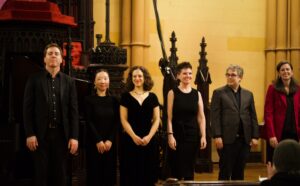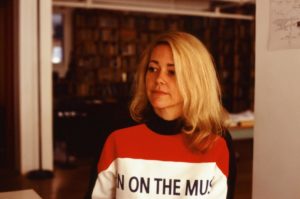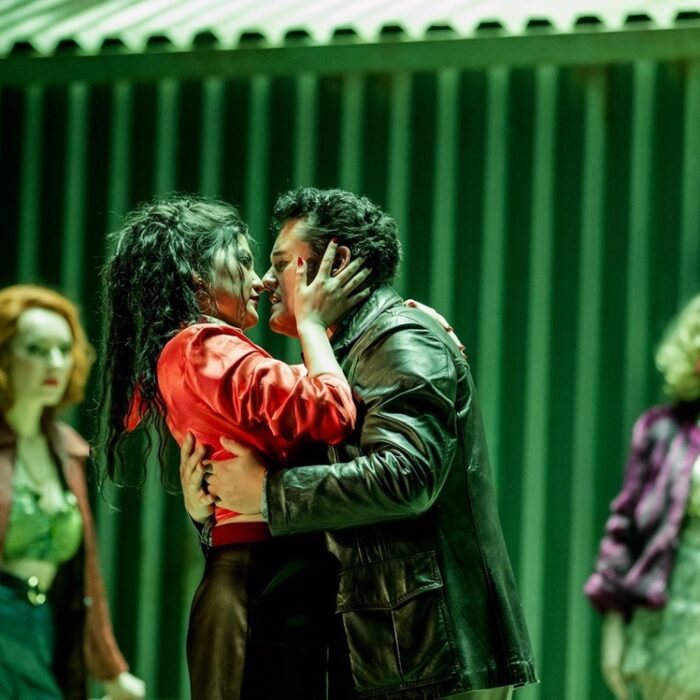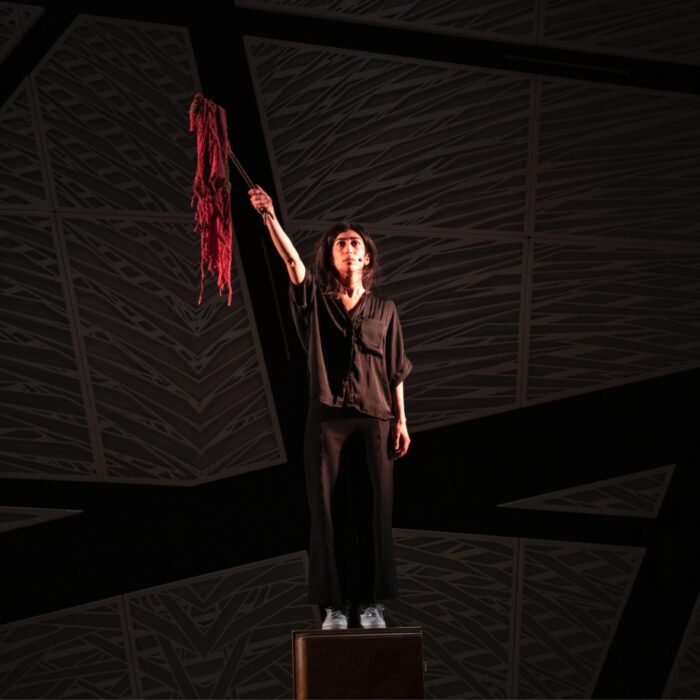
Brooklyn Art Song Society 2023-24 Review: Circles III – The Second Viennese School
By Jennifer Pyron(Photo credit: Catherine Hancock)
Brooklyn Art Song Society (BASS) presented “Circles III: The Second Viennese School” on Friday, Dec. 1, 2023 at the First Unitarian Church of Brooklyn. The organization’s season has been a major hit among art song lovers and listeners who might not find a program like this anywhere else, but right here in Brooklyn.
The season began with two presentations, “Circles I: Clara, Robert & Johannes” and “Circles II: The Wagnerians,” that varied in understanding the complex nuances specifically found among art songs. BASS’ dedication to documenting musical movements through the marriage of poetry and history is what keeps this program vitally relevant today. The deep intertwining of emotional involvements among BASS’ featured composers plays into a broader understanding of what was actually happening in music history and why.
Thanks to BASS’ artistic director Michael Brofman, even the most novice listener of this art form might be hooked into the realm of fascination that can only be felt as intense in an art song – the intuitive synthesis that happens in between words becomes a soothing balm for the soul.
The Second Viennese School
“The Second Viennese School was the self-given title for Arnold Schoenberg (1874-1951) and his two most gifted students, Alban Berg (1885-1935) and Anton Webern (1883-1945). It’s a rather self-confident reference to the First Viennese School: Franz Joseph Haydn, Wolfgang Amadeus Mozart, and Ludwig van Beethoven. Both ‘schools’ certainly shared Vienna as their stomping grounds, although Schoenberg spent the last years of his life in America, but besides that they share not that much in common,” noted Brofman.
From its beginning, The Second Viennese School was set to change the course of art song cycles in reference to musical ideas, but more intentionally in relationship to the creators themselves. Despite the jealousy, rivalry and undeniable genius that this “school” harbored, it did create an opening for more experimental music ideas to awaken and arise. In other words, Schoenberg may not have been for everyone, but it is this radical “may not” that determined the future of what art songs cycles could do and how they could change the art form. One might also consider the composers that were impacted directly by Schoenberg, including but not limited to the obvious Anton Webern and Alban Berg, who felt a sense of compositional freedom that invited them to experiment – John Cage, Hanns Eisler, Lou Harrison, Leon Kirschner, Philip Glass, and many more.
It is also important to examine what Schoenberg’s students might have experienced in such “freeing” times.
“Anton Webern’s relationship to his teacher [Schoenberg] had an almost tragic dimension. He was in many ways an ‘ideal’ pupil, taking Schoenberg’s Serial technique and embracing it wholeheartedly. Berg was content to use Serialism as one of many tools in his toolshed, and even Schoenberg himself moved away from pure serialism in his later works. Webern on the other hand, doubled-down on strictly adhering to tone row writing until his very last works. Webern was drawn to the purity of the system, where every note had a clear, set relationship to every other. His quest for simplicity and purity can be seen as an escape from the complexity and pain of the world around him. During the rise of the Nazi regime Webern lost his two closest artistic companions – Schoenberg fled Europe in 1933 and Berg died suddenly in 1935. To boot, Webern’s music was deemed ‘degenerate’ and banned from performance. This disintegration of the Second Viennese School was a cause of deep distress for Webern, who himself became a victim of the war in its last days when he was mistakenly shot by an occupying American soldier who mistook the composer’s cigarette for a gun,” noted Brofman.
It seemed that while leading up to the evening’s performances, one might not be able to look away from the truth behind every note. That vastness that lies at the core of each composition that is so uniquely Schoenberg, Webern and Berg. The strategic examination of details within the emotional abyss of The Second Viennese School might even bear witness to a greater cause of the time – the unraveling of humanity through the chaos of necessary change.
Anton Webern: Variations for Piano Op. 27 (1936)
Eric Huebner is an American pianist who holds The Anna-Maria and Stephen Kellen Piano Chair with the NY Philharmonic. He is also a professor of music and chair of the music department at the University at Buffalo (SUNY), where he maintains a studio of graduate and undergraduate piano majors and minors and teaches courses in 20th century piano music and piano literature.
It was courageous to begin the evening’s program with Webern’s “Variations for Piano Op. 27,” and one cannot mistake the genius behind this decision – the compositional mirror of the night. What makes these three variations most intriguing is their simplicity. But what makes them feel urgently relevant today is how much nostalgia they carry for listeners who appreciate the beginnings of Webern’s works. The pointillism and dynamic jumps that still excite by generating a visceral response like an unplanned knee jerk. Eric Huebner dominated this task of variations with grace and noticeable gratitude. There were moments where one might have felt like they were witnessing a child happily at play. Huebner brought Webern to life!
Anton Webern: Three Lieder, op. 25 (1935)
Soprano Maggie Finnegan revealed her vocal prowess during the opening phrase of No.1 “Wie bin ich froh!” as she precisely blossomed on ‘froh’ and ‘grün’ through her upper register and sent chills down the spine. Her voice has a pleasant exactness that, instead of pushing listeners, invites them in to enjoy every detail. Finnegan smiled through her eyes in “Wie bin ich froh.” She made Hildegard Jone’s text feel special, especially as she sang “noch einmal bin ich ganz ins Werden hingestellt und bin auf Erden,” “once again I have found myself entirely surrounded by becoming, and am on the earth.”
No.2 “Des Herzens Purpurvogel fliegt durch Nacht” was rich and grounded in Finnegan’s timbre. Her voice mulled over Jone’s text “Doch rastet endlich er am Ast des Todes, müd’ und flügelschwer, dann müssen sie zum letzten Blick verbeben,” “Death, weary and with heavy wings, then they must take their last look around before they dyingly tremble.” One could feel Finnegan’s intent to convey Jone’s message. It was a profound interpretation.
No.3 “Sterne, Ihr silbernen Bienen der Nacht” was full of glitter and sparkle in Finnegan’s voice. She painted a lucid remembering of night’s heavenly bliss through her voice’s warmth and sustainability. There was no separating of any part of the text as Finnegan drew a clear connectivity between the notes. Her voice was like a glossy part of a body of water at night, awaiting to be stirred but never becoming waves.
Alban Berg: Piano Sonata Op. 1 (1910)
Huebner’s interpretation of Berg’s “Piano Sonata Op.1” captivated the hearts of listeners alike. His playing generated levity among complicated phrases that made this piece feel refreshingly light. His phrasing was understated and purposeful at the same time. Huebner’s touch fueled the wonder of the night and might have reminded one of the unquestionable importance of Berg’s complex textures and unique voice.
Alban Berg: Sieben frühe Lieder (1907)
Soprano Jennifer Zetlan and pianist Nana Shi performed Berg’s “Sieben frühe Lieder” with remarkable intuitiveness and intelligence. Zetlan’s serious facial expressions impressed upon listeners to “O gib acht! gib acht!,” “O take heed! take heed!” as she led one further down Berg’s dreamlike path. Zetlan’s impeccable middle register made it easy to navigate the text translations and experience the beauty of Carl Hauptmann’s “Nacht.” Hauptmann was an author of the literary movement of naturalism and Berg’s decision to begin his “Sieben frühe Lieder” with text by Hauptmann is telling of his own personal philosophy. “Nacht” dives into the emotional captivity of humanity, where one cannot deny life as a miracle of nature itself. Nana Shi’s piano playing with Zetlan’s voice during the phrase “ Weites Wunderland ist aufgetan,
Silbern ragen Berge traumhaft groß, Stille Pfade silberlicht talan aus verborg’nem Schoß,” “A vast wonderland opens up, silvery mountains soar dreamlike tall, silent paths climb silver-bright valleywards from a hidden womb,” was absolutely breathtaking.
“Schilflied” with text by Nikolaus Lenau also observes one’s human experience through the eyes of nature, imitating the heart’s beat for one’s lover through a reed song. Zetlan’s silvery soprano wove a tapestry of beautiful sound and captured the essence of Lenau’s text especially as she sang “Und ich mein’, ich höre wehen Leise deiner Stimme Klang, Und im Weiher untergehen Deinen lieblichen Gesang,” “And I seem to hear the soft sound of your voice, and your lovely singing drowning in the pond.”
“Die Nachtigall” might have been one’s most favorite highlight of the night. Zetlan’s voice as she sang Theodor Storm’s text “Die Rosen aufgesprungen,” “The roses have sprung up” will forever be imprinted in one’s memory. Her vocal range became a palette of extraordinary color, waiting for this moment to arise! It was absolutely fantastic!
“Traumgekrönt,” “Crowned with dreams” is a poem by Rainer Maria Rilke that illuminates Berg’s decision to modernize and represent the Second Viennese School by choosing more Symbolist works. “Traumgekrönt” is a perspective about love that is dark and mysterious. The phrase “Und dann, dann kamst du mir die Seele nehmen tief in der Nacht,” “And then, then you came to take my soul at the dead of night,” is underlined by Berg’s tonally ambiguous composition which creates a moment where the singer is totally exposed. Zetlan rose to the occasion as her voice amassed a mix of emotional fright and resolve. She sang ‘Seele nehmen’ with a silvery tone of ethereal lightness. At the end of the poem, “Du kamst, und leis wie eine Märchenweise erklang die Nacht,” “You came, and soft as a fairy tune the night rang out,” Zetlan leaned into ‘die Nacht’ with an overwhelming joy that released into the church’s hall. Her upper register was like a golden dome of delight!
“Im Zimmer,” “In the Room” is like a ray of sunshine following the intensity of “Traumgekrönt.” German poet Johanes Schlaf writes about love’s gentleness in the ‘Herbstsonnenschein,’ ‘Autumn sunshine.’ Nana Shi played the piano with exquisite attention to detail in this song especially as she portrayed the playfulness of love’s melody. Zetlan matched Shi’s attentiveness and the two spun forward a rosy tone of tenderness. For some, this might have made a strong impression about Berg’s sensitivity and emotional intelligence. The Second Viennese School is remembered for this same level of complex emotional awareness, and this is an example of one of Berg’s many contributions.
“Liebesode,” “Ode to Love” and “Sommertage,” “Summer Days” are the two final pieces of Berg’s “Sieben frühe Lieder.” Both Zetlan and Shi continued to masterfully emanate the timeless works suspended in a distant place of infinite knowing, or maybe within each of us just waiting to be revealed. The final phrase “Im Wiesensang verstummt die Brust, nun schweigt das Wort, wo Bild um Bild zu dir zieht und dich ganz erfüllt,” “The heart falls silent in the meadows’ song, words now cease when image after image comes to you and fills you utterly” was the perfect close to a most memorable performance. The audience sat silent just before applauding, taking in all they could through this shared experience of heartfelt wonder. This is the power of music, especially through art songs, and a fine example of how BASS continues to inspire.
Arnold Schoenberg: 3 Klavierstücke, Op. 11 (1909)
Huebner began the Schoenberg portion of the evening’s series by playing “3 Klavierstücke, Op. 11.” In these three piano pieces, Schoenberg showcases atonality at its finest. Huebner played each work with a clear sense of direction, making every note feel purposeful and driven by an overarching design. The middle piece out of the three, “Mässige,” was a highlight of the night for Huebner. He played with a dreamlike energy that might have carried listeners into another realm of pure bliss. It is very rare to use such flowery comments when describing Schoenberg’s atonal context, however this particular live performance was a one-of-a-kind.
Arnold Schoenberg: Das Buch der hängenden Gärten, Op.15
Mezzo soprano Kate Maroney was the perfect choice for Schoenberg’s “The Book of Hanging Gardens.” During this 15 part song cycle, Maroney’s voice morphed into a series of expressive tonal colors and emotions. More than any other part of the evening’s performances, one might have closed their eyes in enjoyment instead of navigating the text translations. Also, considering the climactic moment of song 11, “Als wir hinter dem beblühmten Tore,” “As we, behind the flowery gate,” the singer awakens to find the two lovers meeting and uses the voice to convey overwhelming infatuation.
Columbia University’s Marilyn McCoy also touched upon this during her pre-lecture. Ultimately, Maroney’s vocal direction was heading towards this moment to really let loose and completely unfurl her rich mezzo palette. Maroney’s voice was spectacular as she sang the phrase, “Der blick vor dem ich ohne lass gekniet Mich fragend suchte oder zeichen gäbe,” “The gaze before which I had kneeled unceasingly Was questioningly seeking me or giving me signs,” in song four. One could tell she was on the brink of something special from this point forward. There was also a magical, purely guttural response in her voice during the phrase, “Und weinen dass die bilder immer fliehen Die in schöner finsternis gediehen – Wann der kalte klare morgen droht,” “And weeping that the images ever flit away, The images that flourished in beautiful darkness – When the cold, clear morning threatens.”
Michael Brofman also did a wonderful job playing the piano for this song cycle. Especially transformative moments included his playing just after the phrase, “Der wächter nicht die rasch uns scheiden dürfen,” “Think not of the watchmen, who are permitted to part us abruptly,” during song 12. Another memorable moment occurred as Brofman played just at the end of No. 13, “Du lehnest wider eine silberweide,” “You lean against a silver willow.” The piano became transparent as every note lifted into the church hall.
Maroney and Brofman performed No. 14, “Sprich nicht immer,” “Do not always speak,” with intensity and flare. One could not deny the burning feelings as Maroney sang “Und der lichter Deren flimmer Wandelbar,” “And of the lights Whose flickering Is changeable.”
The final song No. 15, “Wir bevölkerten die abend-düstern,” “We inhabited the evening-dimmed,” was rich with the evening’s magic-driven energy and concluded “Circles III: The Second Viennese School” with a reminder of Schoenberg’s genius. Maroney’s mezzo was full of strength and drama as she sang the closing phrase of Stefan George’s text, “Jagen ruckweis unsichtbare hände Draussen um des edens fahle wände. Die nacht ist überwölkt und schwül,” “Is whirled about erratically by unseen hands outside about the dull walls of Eden. The night is clouded and sultry.” Brofman struck the final chords full of longing and despair, leaving the audience without a resolution to grasp.
The infinite vastness of the unknown laid bare for every listener to feel, brought the evening’s program full circle. One might have closed their eyes and hoped for peace, while another might have kept their eyes open, knowing it is vital to never look away.
Categories
Reviews


